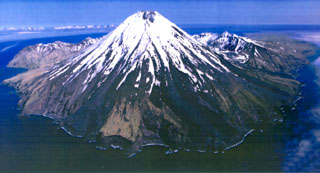Report on Kanaga (United States) — December 1993
Bulletin of the Global Volcanism Network, vol. 18, no. 12 (December 1993)
Managing Editor: Edward Venzke.
Kanaga (United States) Summit-crater eruption generates steam and ash emissions
Please cite this report as:
Global Volcanism Program, 1993. Report on Kanaga (United States) (Venzke, E., ed.). Bulletin of the Global Volcanism Network, 18:12. Smithsonian Institution. https://doi.org/10.5479/si.GVP.BGVN199312-311110
Kanaga
United States
51.923°N, 177.168°W; summit elev. 1307 m
All times are local (unless otherwise noted)
Pilots and ground observers reported low-level eruptive activity in late December through mid-January. On 29 December, a pilot reported that Kanaga was steaming more than usual; observers in the village of Adak . . . also saw the steaming. Several days later, FWS personnel climbing Mount Moffett near Adak smelled sulfur. On 7 January, Navy personnel in Adak reported increased steam emissions from numerous locations near the summit, with all snow gone from the summit area. The next day, steam was pouring out of the summit crater, the rim was dark, possibly blackened by ash, and sulfur smells were reported in Adak. Poor weather obscured the volcano until 13 January, when observers in Adak reported that the S flank was covered with ash and that steam was still rising from the summit crater. They also reported "dark smoke" coming from a fissure and a nearby vent on the SE flank; the "smoke" did not rise above the summit. During the week of 14-21 January, pilots reported low-level steam-and-ash emissions, with local ashfall on the flanks of the volcano. A plume extending SW was also detected on satellite imagery early in the week.
Geological Summary. Symmetrical Kanaga stratovolcano is situated within the Kanaton caldera at the northern tip of Kanaga Island. The caldera rim forms a 760-m-high arcuate ridge south and east of Kanaga; a lake occupies part of the SE caldera floor. The volume of subaerial dacitic tuff is smaller than would typically be associated with caldera collapse, and deposits of a massive submarine debris avalanche associated with edifice collapse extend nearly 30 km to the NNW. Several fresh lava flows from historical or late prehistorical time descend the flanks of Kanaga, in some cases to the sea. Historical eruptions, most of which are poorly documented, have been recorded since 1763. Kanaga is also noted petrologically for ultramafic inclusions within an outcrop of alkaline basalt SW of the volcano. Fumarolic activity occurs in a circular, 200-m-wide, 60-m-deep summit crater and produces vapor plumes sometimes seen on clear days from Adak, 50 km to the east.
Information Contacts: AVO.

